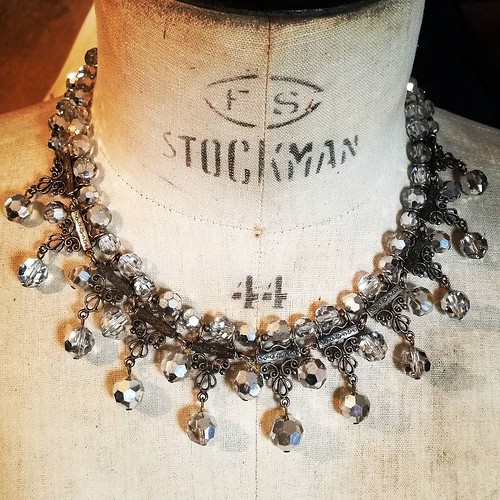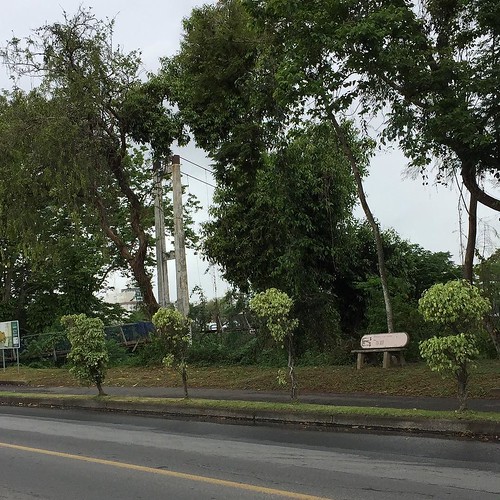Clinical significance of your impact of intrinsic CD44v9 expression on chemoradioselection and patients survival, we compared the expression levels of CD44v9 inside the 60 untreated biopsy specimens obtained from CRS and N-CRS sufferers. There was no significant difference in CD44v9 expression levels involving the CRS and N-CRS samples. Also, CD44v9 positivity didn’t impact Kaplan-Meier DSS curves either inside the CRS plus N-CRS cohort or within the N-CRS cohort. Equivalent benefits had been obtained together with the univariate Cox proportional hazard model. These final results recommend that the expression levels of intrinsic CD44v9 in the biopsy specimens are usually not valuable as a predictor of chemoradioselection along with the patient survival. Expression of CD44v9 in the surgically removed specimens In view of the above findings, we analyzed no matter whether the expression levels of CCRT-induced CD44v9 have been ASP015K correlated using the unfavorable outcomes within the surgically removed specimens obtained from N-CRS individuals. The basis for this evaluation was the earlier observation that induction chemotherapy apparently enhanced the subset of CD44v9-expressing cells in the HNSCC tumors. In N-CRS individuals, the CD44v9-positive group demonstrated considerably worse DSS than the CD44v9-negative group . Considering that it was confirmed that the key tumor web-site didn’t have an effect on the DSS as described above, we examined the effects of four components i.e., T, N, tumor responses to CCRT, and  CD44v9 positivity around the DSS rate of sufferers by both univariate and multivariate analyses with a Cox proportional PubMed ID:http://jpet.aspetjournals.org/content/120/2/255 hazard model. The univariate analyses demonstrated significantly increased dangers of disease-specific death in CD44v9-positive sufferers and with sophisticated N. In multivariate analyses, CD44v9 positivity and sophisticated N stage have been drastically correlated with poor prognosis, suggesting that among these four elements, CD44v9 expression level is an beneficial biomarker inside the N-CRS population, as well as advanced N stage. Comparison of paired samples We then analyzed whether the CD44v9-positivity in the biopsy specimen correlated using the induction of CD44v9 in the surgically removed specimens. Intriguingly, the increases of CD44v9 score were observed predominantly in individuals with CD44v9-negative biopsy specimens than CD44v9-positive individuals. The expression levels of CD44v9 inside the biopsy specimens didn’t correlate together with the grading of tumor response to CCRT evaluated inside the paired surgically removed specimens. We further compared DSS curves amongst the CD44v9-induced group and CD44v9-non-induced group and identified that former had a significantly worse DSS price. Taken together, these benefits strongly indicated that CCRT-induced CD44v9 expression in lieu of intrinsic expression is actually a therapeutic hurdle to chemoradioselection. Discussion Through the last decade, the mainstay of treatment for advanced HNSCC has shifted from initial radical surgical Fumarate hydratase-IN-2 (sodium salt) price resection combined with postoperative radiotherapy to dose-intensified therapy protocols, that are primarily aimed at organ preservation. This trend has been markedly sophisticated by the current introduction of CCRT Disease distinct survival curves based on the CD44 v9 positivity of surgically removed samples obtained from 72 non-chemoradioselected patients. Diseasespecific survival curves of 30 N-CRS sufferers who had paired biopsy and surgically removed samples. The individuals have been divided into 2 groups according to their levels of CD44v9 expression just before and soon after concurrent chemoradiotherapy.Clinical significance of the effect of intrinsic CD44v9 expression on chemoradioselection and individuals survival, we compared the expression levels of CD44v9 inside the 60 untreated biopsy specimens obtained from CRS and N-CRS sufferers. There was no considerable distinction in CD44v9 expression levels among the CRS and N-CRS samples. Also, CD44v9 positivity did not influence Kaplan-Meier DSS curves either in the CRS plus N-CRS cohort or within the N-CRS cohort. Comparable benefits had been obtained together with the univariate Cox proportional hazard model. These final results recommend that the expression levels of intrinsic CD44v9 inside the biopsy specimens are certainly not useful as a predictor of chemoradioselection and also the patient survival. Expression of CD44v9 within the surgically removed specimens In view with the above findings, we analyzed no matter if the expression levels of CCRT-induced CD44v9 have been correlated using the unfavorable outcomes within the surgically removed specimens obtained from N-CRS sufferers. The basis for this evaluation was the earlier observation that induction chemotherapy apparently enhanced the subset of CD44v9-expressing cells inside the HNSCC tumors. In N-CRS patients, the CD44v9-positive group demonstrated significantly worse DSS than the CD44v9-negative group . Since it was confirmed that the principal tumor internet site did not have an effect on the DSS as pointed out above, we examined the effects of four aspects i.e., T, N, tumor responses to CCRT, and CD44v9 positivity around the DSS price of individuals by both univariate and multivariate analyses using a Cox proportional PubMed ID:http://jpet.aspetjournals.org/content/120/2/255 hazard model. The univariate analyses demonstrated substantially improved risks of disease-specific death in CD44v9-positive sufferers and with advanced N. In multivariate analyses, CD44v9 positivity and advanced N stage were substantially correlated with poor prognosis, suggesting that among these 4 variables, CD44v9 expression level is an beneficial biomarker inside the N-CRS population, as well as sophisticated N stage. Comparison of paired samples We then analyzed regardless of whether the CD44v9-positivity within the biopsy specimen correlated together with the induction of CD44v9 in the surgically removed specimens. Intriguingly, the increases of CD44v9 score were observed predominantly in sufferers with CD44v9-negative biopsy specimens than CD44v9-positive patients. The expression levels of CD44v9 inside the biopsy specimens didn’t correlate with all the grading of tumor response to CCRT evaluated inside the paired surgically removed specimens. We additional compared DSS curves among the CD44v9-induced group and CD44v9-non-induced group and discovered that former had a drastically worse DSS price. Taken together, these benefits strongly indicated that CCRT-induced CD44v9 expression rather than intrinsic expression is really a therapeutic hurdle to chemoradioselection. Discussion During the last decade, the mainstay of remedy for sophisticated HNSCC has shifted from initial radical surgical resection combined with postoperative radiotherapy to dose-intensified treatment protocols, which are primarily aimed at organ preservation. This trend has been markedly sophisticated by the recent introduction of CCRT Illness particular survival
CD44v9 positivity around the DSS rate of sufferers by both univariate and multivariate analyses with a Cox proportional PubMed ID:http://jpet.aspetjournals.org/content/120/2/255 hazard model. The univariate analyses demonstrated significantly increased dangers of disease-specific death in CD44v9-positive sufferers and with sophisticated N. In multivariate analyses, CD44v9 positivity and sophisticated N stage have been drastically correlated with poor prognosis, suggesting that among these four elements, CD44v9 expression level is an beneficial biomarker inside the N-CRS population, as well as advanced N stage. Comparison of paired samples We then analyzed whether the CD44v9-positivity in the biopsy specimen correlated using the induction of CD44v9 in the surgically removed specimens. Intriguingly, the increases of CD44v9 score were observed predominantly in individuals with CD44v9-negative biopsy specimens than CD44v9-positive individuals. The expression levels of CD44v9 inside the biopsy specimens didn’t correlate together with the grading of tumor response to CCRT evaluated inside the paired surgically removed specimens. We further compared DSS curves amongst the CD44v9-induced group and CD44v9-non-induced group and identified that former had a significantly worse DSS price. Taken together, these benefits strongly indicated that CCRT-induced CD44v9 expression in lieu of intrinsic expression is actually a therapeutic hurdle to chemoradioselection. Discussion Through the last decade, the mainstay of treatment for advanced HNSCC has shifted from initial radical surgical Fumarate hydratase-IN-2 (sodium salt) price resection combined with postoperative radiotherapy to dose-intensified therapy protocols, that are primarily aimed at organ preservation. This trend has been markedly sophisticated by the current introduction of CCRT Disease distinct survival curves based on the CD44 v9 positivity of surgically removed samples obtained from 72 non-chemoradioselected patients. Diseasespecific survival curves of 30 N-CRS sufferers who had paired biopsy and surgically removed samples. The individuals have been divided into 2 groups according to their levels of CD44v9 expression just before and soon after concurrent chemoradiotherapy.Clinical significance of the effect of intrinsic CD44v9 expression on chemoradioselection and individuals survival, we compared the expression levels of CD44v9 inside the 60 untreated biopsy specimens obtained from CRS and N-CRS sufferers. There was no considerable distinction in CD44v9 expression levels among the CRS and N-CRS samples. Also, CD44v9 positivity did not influence Kaplan-Meier DSS curves either in the CRS plus N-CRS cohort or within the N-CRS cohort. Comparable benefits had been obtained together with the univariate Cox proportional hazard model. These final results recommend that the expression levels of intrinsic CD44v9 inside the biopsy specimens are certainly not useful as a predictor of chemoradioselection and also the patient survival. Expression of CD44v9 within the surgically removed specimens In view with the above findings, we analyzed no matter if the expression levels of CCRT-induced CD44v9 have been correlated using the unfavorable outcomes within the surgically removed specimens obtained from N-CRS sufferers. The basis for this evaluation was the earlier observation that induction chemotherapy apparently enhanced the subset of CD44v9-expressing cells inside the HNSCC tumors. In N-CRS patients, the CD44v9-positive group demonstrated significantly worse DSS than the CD44v9-negative group . Since it was confirmed that the principal tumor internet site did not have an effect on the DSS as pointed out above, we examined the effects of four aspects i.e., T, N, tumor responses to CCRT, and CD44v9 positivity around the DSS price of individuals by both univariate and multivariate analyses using a Cox proportional PubMed ID:http://jpet.aspetjournals.org/content/120/2/255 hazard model. The univariate analyses demonstrated substantially improved risks of disease-specific death in CD44v9-positive sufferers and with advanced N. In multivariate analyses, CD44v9 positivity and advanced N stage were substantially correlated with poor prognosis, suggesting that among these 4 variables, CD44v9 expression level is an beneficial biomarker inside the N-CRS population, as well as sophisticated N stage. Comparison of paired samples We then analyzed regardless of whether the CD44v9-positivity within the biopsy specimen correlated together with the induction of CD44v9 in the surgically removed specimens. Intriguingly, the increases of CD44v9 score were observed predominantly in sufferers with CD44v9-negative biopsy specimens than CD44v9-positive patients. The expression levels of CD44v9 inside the biopsy specimens didn’t correlate with all the grading of tumor response to CCRT evaluated inside the paired surgically removed specimens. We additional compared DSS curves among the CD44v9-induced group and CD44v9-non-induced group and discovered that former had a drastically worse DSS price. Taken together, these benefits strongly indicated that CCRT-induced CD44v9 expression rather than intrinsic expression is really a therapeutic hurdle to chemoradioselection. Discussion During the last decade, the mainstay of remedy for sophisticated HNSCC has shifted from initial radical surgical resection combined with postoperative radiotherapy to dose-intensified treatment protocols, which are primarily aimed at organ preservation. This trend has been markedly sophisticated by the recent introduction of CCRT Illness particular survival  curves determined by the CD44 v9 positivity of surgically removed samples obtained from 72 non-chemoradioselected patients. Diseasespecific survival curves of 30 N-CRS individuals who had paired biopsy and surgically removed samples. The individuals had been divided into two groups as outlined by their levels of CD44v9 expression ahead of and immediately after concurrent chemoradiotherapy.
curves determined by the CD44 v9 positivity of surgically removed samples obtained from 72 non-chemoradioselected patients. Diseasespecific survival curves of 30 N-CRS individuals who had paired biopsy and surgically removed samples. The individuals had been divided into two groups as outlined by their levels of CD44v9 expression ahead of and immediately after concurrent chemoradiotherapy.